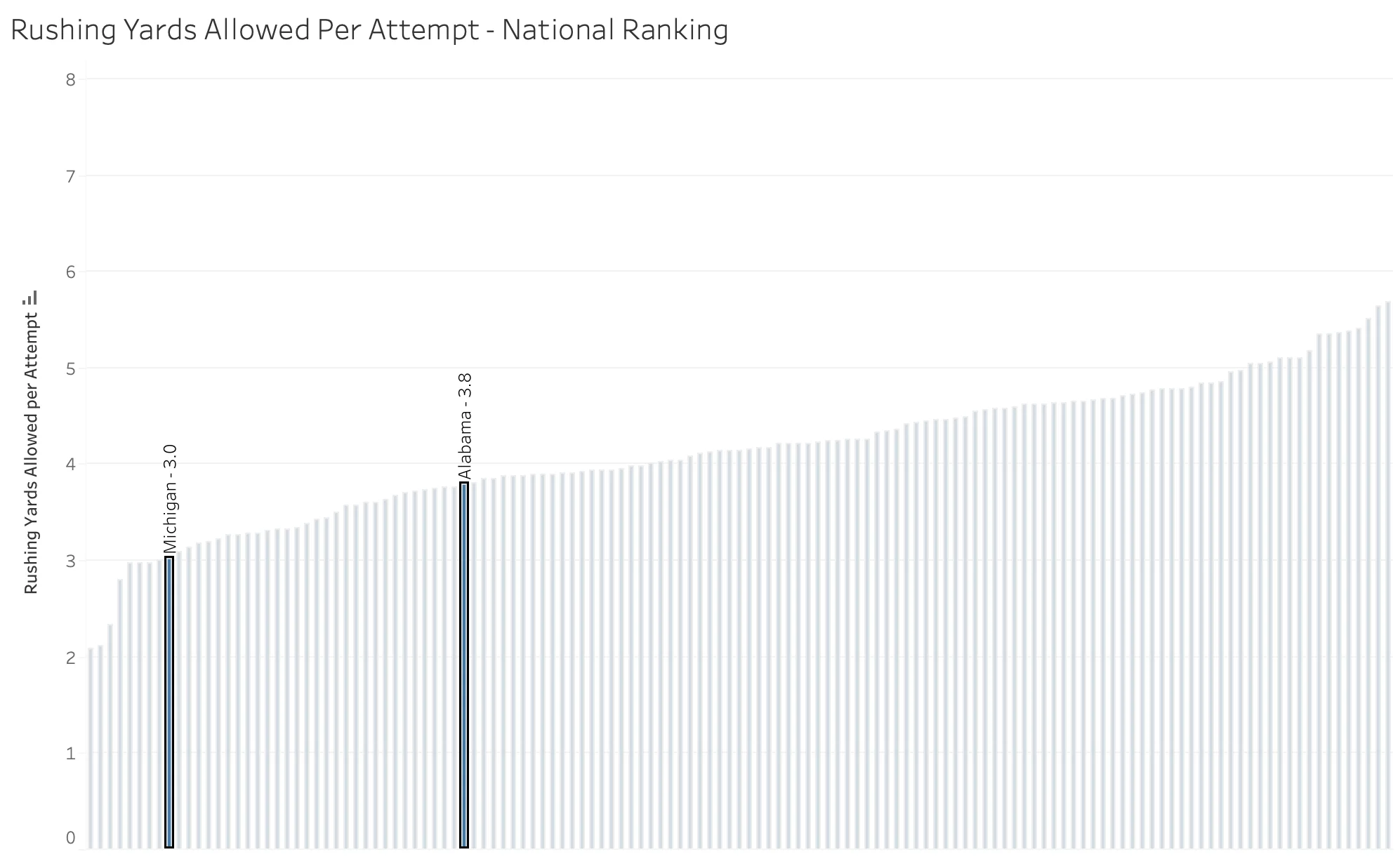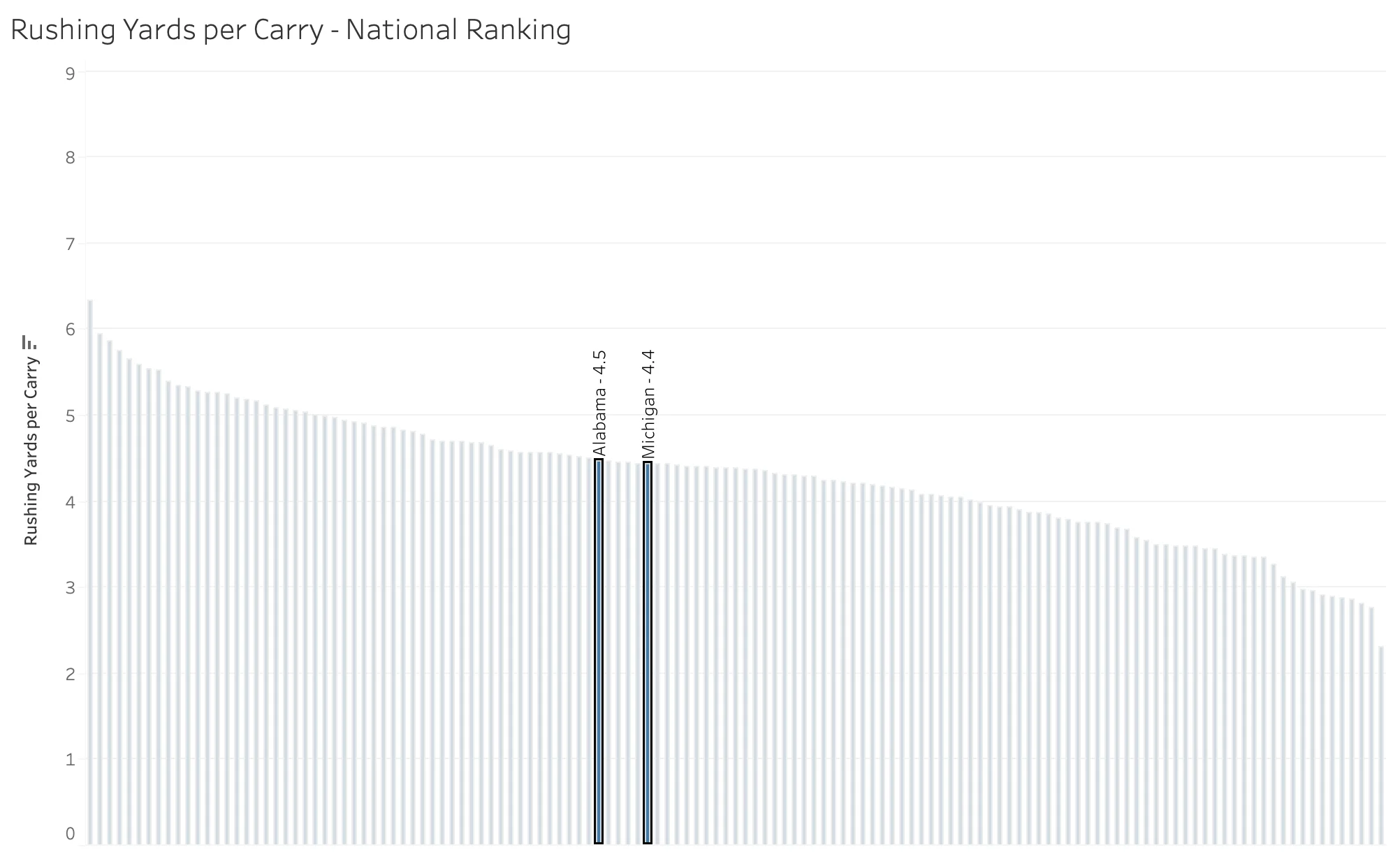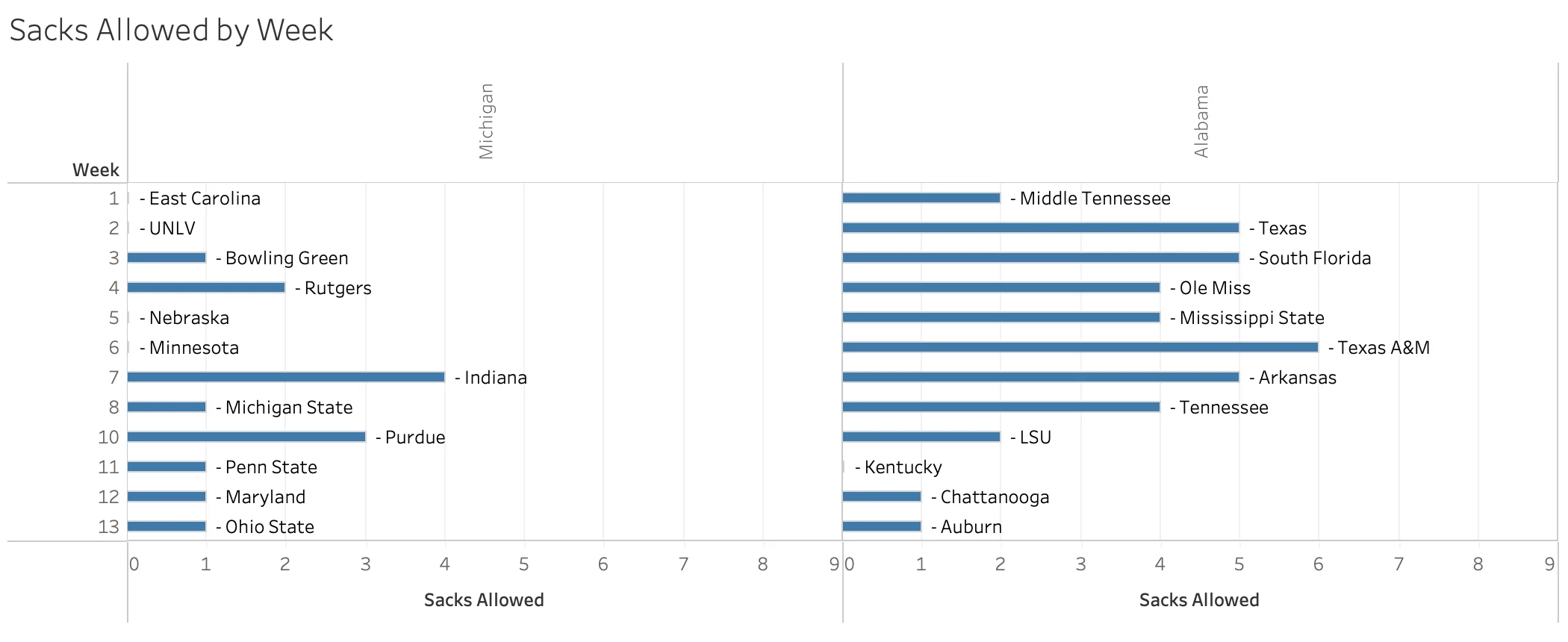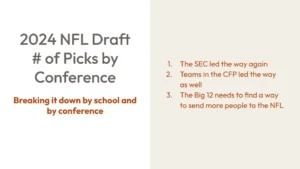Alabama opened as an underdog to Michigan, yet the general public is predicting Alabama in the title game. “Alabama vs Texas” is a rematch college football fans are craving, and their hunger for said rematch is leading to unbalanced predictions in favor of the Tide. The Tide rolling over Michigan is plausible, for Alabama is coached by the greatest to ever walk the Saturday sidelines. Alabama also has one of the most talented rosters (measured by recruiting rankings). And they enter the Rose Bowl having beaten Georgia. Yet, Michigan comes into this playoff with measurable program gusto, having built its own tide of momentum over the course of the past 3 seasons. This begs a question: Can Michigan beat Alabama?
A story of identity
The story of the matchup between Michigan and Alabama is one of identity. Michigan will arrive in Pasadena with a hardened identity, having forged its purpose in the fire of 3 seasons of gritty football. In an era of RPO, spread offenses, and quarterbacks who are part centaur, Michigan brings an air of old-school grit with moments of modern day offense.
Michigan’s identity is tough. To sum up their offensive identity, you could phrase it in one sentence. “I’m going to run the ball to the right, and there is nothing you can do to stop me.” Their defense, likewise, is back-alley bruising and punishing. This identity was tested, yet further strengthened, during several Jim Harbaugh suspensions and sign stealing allegations in the 2023 season. Through it all, Michigan is seemingly unscathed, no worse for the wear.
The Wolverines fly to the Rose Bowl having known their identity for several years now. They entered the 2023 season knowing exactly who they were, and to their credit, they’ve stayed true to that identity all season long.
Alabama, on the other hand, entered the 2023 season with a general sense of identity founded in their coach, Nick Saban. You know that a Nick Saban team is going to be (a) extremely talented, (b) tough in the trenches, and (c) disciplined yet adaptable. Saban has coached teams with quarterbacks ranging from game managers to Heisman Trophy winners. While the quarterback position is the most important single position in today’s game, he has shown that you can win without your QB striking the Heisman pose in mid-December in New York City.
This season, however, Alabama had more questions than answers during fall camp around their quarterback position. There were whispers that there was a greater level of uncertainty than usual. Podcasters and pundits even suggested that Alabama would take a step back this year after losing 2 whole games the prior year (the building is burning! 2 losses!).
And, as the season started, Alabama did not feel much more confident in the QB position. After romping over Middle Tennessee State (not to be confused with Left or Right Tennessee State), Alabama struggled in their week 2 loss to Texas. Milroe did throw for 255 yards, but he completed only 14 of 27 passes (51%). The following week, Bama completed 10 passes on 23 attempts for an abysmal 43% completion rate. The sky was falling, and there were questions, rightly so, about whether or not Alabama had returned to earth.
Yet, as the season went on, Alabama figured out how to use Jalen Milroe and they figured out his super power: Run like LeBron James. He certainly has a big arm, but when a play breaks down, he looks like a CFB version of LeBron James with his size and athleticism. His escapability from the pocket is uncanny, fueled by elite wheels. His basketball “first step” equivalent in football is that ability to make the first defender miss, usually in the pocket.
As Jalen Milroe figured out his abilities, Bama grew with him. Passing yardage increased generally as the season went on. And so, in Bama, we have a team who found their identity through the course of the season.
So, that brings us back to the story of identity. When one team knew their identity and stayed true to it while the other team had to discover it, whose identity will hold sway come Rose Bowl kickoff time?
Can Michigan beat Alabama?
While most Michigan fans have projected a Wolverines win, I’ve observed most neutral observers are reticent to pick the Maize and Blue. Bill Connelly phrased it well when he said it is hard to pick against Nick Saban and Alabama. The Tide come rolling into this game on the heels of a miracle Iron Bowl victory followed by a defeat of defending champion Georgia. Its momentum is at high tide, you might say (the puns are not going away). That is in part because the team didn’t just silently slip into the CFP room of 4. No. They ended Georgia’s 28 game win streak and hopes of an historic three-peat. Talk about the elephant in the room…
While Michigan has its own momentum, it slipped into the CFP rather unceremoniously, thanks in part to the FSU debacle. It was clear that Michigan would be in after they beat their hated rival Ohio State. And, that victory should stand on its own as a momentum builder and one of the better victories of the year. But, the sign stealing allegations and showcase that Alabama put on at the end of the season leave some people forgetting that Michigan is the #1 seed.
To hearken back to the question I posed at the outset: “Can Michigan beat Alabama?”
The short answer is yes.
But, the more nuanced answer would answer the question: “How can Michigan beat Alabama?” Let me attempt to explain one way in which Michigan can scheme to beat Alabama. It is built on three key pillars:
- Lean into your identity
- Remember your identity for all 60 minutes
- Stop one of Alabama’s three main play types and limit a second
Michigan needs to lean into its identity
For Michigan to beat Alabama, they need to game plan around their strengths. They could put the following up on the mirror and at the top of their coordinators’ play sheets:
- Michigan is tough
- Michigan dominates the line of scrimmage
- Michigan limits big plays
- Michigan is tough
While their numbers were modest for rushing yards per game (53rd in the country with 170 yards per game) and rushing yards per carry (58th in the country with 4.4 yards per carry), the Wolverine defense allowed 91 yards rushing per game. That was good for 9th best in the country.
In case you are wondering, Alabama allowed 128 yards per game on the ground, which was good for 35th in the country.
Furthermore, Michigan allowed only 3 yards per rushing attempt. Alabama averaged 4.5 yards per carry on the ground, so something is going to give. In my opinion, advantage goes to Michigan.

Why would Michigan have the advantage? Well, Georgia, which almost universally is accepted as being big and gnarly and also tough, allowed 4 yards per carry on the ground this year, and we saw Alabama gash them time and time on first down in the SEC Championship. But this year’s Michigan is closer to the 2021 and 2022 Georgia teams from a metric standpoint, and everyone struggled to run on those Georgia teams.
Said another way, Alabama’s gashing of Georgia was less impressive than had it occurred in 2021 or 2022. Therefore, I wouldn’t overcorrect and overstate Alabama’s ability to dominate in the ground game.

Michigan needs to remember their identity for all 60 minutes
When I say Michigan needs to remember their identity for all 60 minutes, you might be wondering, “Well, duh, don’t they always? Look at their season. Look at their past two seasons. Look at their past three seasons. 35 wins, 3 conference titles, and 3 CFP appearances.”
Let me tell you a story of a time when Michigan forgot who they were and how it cost them dearly.
Rewind the clock back to the 2022 season’s Fiesta Bowl when Michigan played TCU. Michigan started the game off with a 54 yard Donovan Edwards run straight up the middle. This was Michigan football. There had been conversation leading up to the game that TCU didn’t really belong (after all, they didn’t win their conference championship game), and that first play appeared to confirm the suspicions. However, seven plays later, on a 4th and goal from the 2 yard line, Michigan forgot who they were.
Instead of trusting their super power, the offensive line, and running up the gut with Edwards or McCarthy, they tried a double hand-off reverse that looked for a pass to the QB. Colston Loveland, a tight end, ended up with the ball on the double reverse, and he looked for J.J. McCarthy, but McCarthy was smothered, and Loveland could not outrace several oncoming Horned Frogs.
By early in the second quarter, TCU was up 14-3 with the ball. Rod Moore picked off Max Duggan, and on the next play, J.J. McCarthy completed a 50 yard bomb to Roman Wilson. A play that will go down in Michigan history lore as a “what could have been” type of play, the referees called Wilson down on the 1 yard line, though arguably the ball crossed the goal line before his knee was down. Then, Michigan again forgot who they were.
Again, instead of trusting their RB, a budding star in Donovan Edwards, they handed the ball to Kalel Mullings who fumbled the ball and TCU recovered.
If Michigan made either of those plays, that game would have ended differently. In all reality, Michigan likely would have won by double digits and earned its rematch with Georgia.
What did forgetting who they were cost the Maize and Blue? A chance at redemption and to hold the CFP title in their hands.
This year, Michigan needs to be Michigan. Don’t outthink yourselves at the goal line. If it is a play that you think the other team won’t be prepared for, and you cooked it up last week, chances are you won’t be prepared for it either. This is not a time to pull out the oddities from the antique and thrift stores. This is a time to ground and pound and do what Michigan does best.
Alabama will know what is coming, and they may stop the Wolverines. But, then fans and the program would at least know they went down giving it their best shot rather than being left to dwell on a year of “What if we hadn’t forgotten who we are?”
Stop one of Alabama’s three main play types and limit a second
I am going to simplify Alabama’s offensive playbook down to three types of plays:
- The traditional run with the RBs
- Chunk yardage through the air
- Jalen Milroe scramble special
Jalen Milroe isn’t your typical drop back quarterback. Rather than getting to his drop and then releasing, he takes his drop and then settles into the pocket. Sitting behind an iron clad wall for an offensive line, he’s able to patiently wait until he can sling it, generally past the first down marker. In the instances where a defender breaks through the O-line fortress, he scrambles.
His checkdown is not your typical checkdown. First, it is not immediate. Second, it is either to a receiver in scramble mode, or it is to his own set of legs that immediately jump into scramble mode. This presents a challenge and an opportunity.
The challenge is that he is almost LeBron James like in his athleticism when he runs. He has an extra gear to get out of the backfield and to turn his steam engine upfield. There was a play against Auburn where he ducked a defender from nearly 10 yards deep in the pocket, and then he scrambled to his right to gain positive yardage. The dilemma is whether or not to bring a spy (or two) to cover him, or to use those guys in coverage. When Georgia and Auburn did not bring a spy, Milroe made them pay. Yet, he also made enough plays with his arm that a team cannot simply spy all game long.
However, nobody is perfect. And that presents the opportunity.
Alabama’s offensive line is not necessarily iron clad. They are getting closer to that, but they have not been impenetrable all year long. Alabama has allowed an enormous amount of sacks compared to Michigan…and well…compared to the rest of the country. By a count of 39 to 14! That’s essentially 3+ per game versus ~1.

Michigan has a chance to cause havoc for Milroe. Georgia did to a degree with 4 sacks. Michigan comes in at 42nd in the nation with 28 sacks on the regular season. If they can get to Milroe, which they have a really good chance at, then they can give him grief all game.
Milroe holds onto the ball for a long time. And the Alabama front line, which I previously described as “iron clad”, actually was not iron clad for a good chunk of the season. In 7 of their first 8 games, Alabama gave up no less than 4 sacks per game. However, over the last 4 games, they gave up 4 total sacks. Then, against Georgia, it was back to 4 sacks. So, there is a chink in the armor that protects Milroe.

Perhaps the sacks come because Milroe holds onto the ball for so long…generally. Yet, there are those plays when he drops back and essentially gives a 3 Mississippi (or does he say “1 Alabama, 2 Alabama, 3 Alabama…?”) before he dove off. Against Auburn, as the game wound down in the second half, he was more likely to tuck and run than he was to move through his progressions.
| Metric | Alabama | Michigan |
| Explosive Passing Plays (national rank) | 62 (20th) | 64 (17th) |
| Explosive Passing Plays Allowed (national rank) | 38(34th) | 32(18th) |
So, the opportunity is there for Michigan.
Alabama’s run game sets up the pass game. The pass game sets up the Milroe scramble game. Knowing that stopping all three basic play types for Alabama is nigh unto impossible and unrealistic, you have to stop one nearly completely (materially that is). You have to really limit another. Then the third you can’t get killed by it and lose the game on a few big plays. Here is how I would scheme it for Michigan if I was Jesse Minter:
- I would STOP the traditional ground game
- I would LIMIT the Milroe scramble
- I would LIVE with the pass game and seek to not be killed by it
Target the strengths and more predictable areas of the game to be the ones you can stop or limit. Milroe’s running is somewhat unpredictable, but you also know that it generally comes from a broken down pass play that you can slow down with a spy or a sack.
If you can stop the ground game, that makes Alabama more two dimensional. Yes, I’m calling Milroe’s running a third dimension. The Milroe scrambles almost always end up in first downs AND they are huge for momentum. They choke the momentum of the defense and they buoy up the offense.
Milroe has not yet proven the ability to pick apart a team in the pass game. Michigan’s secondary has proven to be one of the better units in the country, so I would trust those guys to make the plays needed to win.
When Texas beat Bama, they held Bama to 107 yards rushing on 35 carries. If Michigan does that, they have a good chance.


